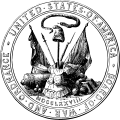District of Utah
During the American Civil War in the early 1860s, the District of Utah was a subordinate district of the U.S. Army's Department of the Pacific. The district was composed of territorial areas that later became parts of the modern U.S. states of Idaho, Nevada, and Utah.
History
On August 6, 1862, the Department of the Pacific absorbed the District of Utah, the territory of the former Department of Utah which had been discontinued on July 3, 1861; the remaining troops had marched out August 9. The District of Utah was composed of the Territory of Nevada and the Territory of Utah. General Connor established its headquarters at Fort Ruby on August 6, 1862. After a visit to Salt Lake City he returned and on October 20, moved his headquarters to Camp Douglas, about three miles east of Salt Lake City, Utah where his forces could overlook and intimidate the Mormon leadership who he regarded as traitors to the Union.[1] On August 20, 1863, the area of Soda Springs, Idaho Territory was added to the district. His District also provided a garrison for Fort Bridger. The Territory of Nevada became the State of Nevada and was admitted to the Union on October 31, 1864.[2]
Commanders
- Colonel Patrick Edward Connor August 6, 1862 - February 17, 1865 (Department of the Pacific)
- Brigadier General Patrick Edward Connor February 17, 1865 - March 28, 1865 (Department of the Missouri)
On February 17, 1865, the District of Utah was transferred from the Department of the Pacific into the Department of the Missouri. On March 28, 1865, the district was merged into the Department of the Plains, under Connor's command.[3] On June 27, 1865, the State of Nevada and Territory of Utah became part of the expanded Department of California that also consisted of the State of California and the Territory of New Mexico and Territory of Arizona.[4]
Posts
- Mormon Station, Nevada 1849–1910
- Camp Floyd, Utah, 1858–1861; Fort Crittenden, 1861–1862
- Fort Churchill, Nevada 1860–1869
- Camp Schell, Nevada, 1860–1862
- Fort Schellbourne, Nevada, 1862–1869
- Camp Nye, Nevada 1861–1865 [5]
- Camp Douglas, Utah 1862–1878
- Fort Ruby, Nevada 1862–1869
- Camp Smoke Creek, Nevada, 1862–1864[6]
- Camp Cedar Swamps, Utah, 1863
- Camp Connor, Idaho Territory, 1863–1865 [7]
- Camp Dun Glen (1863, 1865–1866)[8]
- Fort Trinity, Nevada, 1863 - 1864 [9]
- Antelope Station, Nevada, 1864 [10]
- Fort Baker, Nevada 1864
- Camp Bingham Creek, Utah, 1864[11]
- Camp Relief, Utah, 1864
- Deep Creek Station, Nevada, 1864 [12]
- Quinn River Camp 1865
- Fort McDermitt, Nevada 1865–1889
- Camp McGarry, Nevada 1865–1868
- Camp McKee, Nevada 1865–1866 [13]
- Camp Overend, Nevada, 1865 [14]
- Salt Lake City Post, Utah, 1865–1866[15]
See also
- California in the American Civil War
- Nevada in the American Civil War
- Utah in the American Civil War
References
- ^ The war of the rebellion, Volume 124, pp. 119-120, Letter from Col. Connor to Maj. R. C. Drum, September 11, 1862
- ^ David J. Eicher, Civil War High Commands, Stanford University Press, 2001, p.849
- ^ Eicher, Civil War High Commands, p.849
- ^ Military Division of the United States After The Civil War, GENERAL ORDERS No. 118.
- ^ Near Carson City, A depot for California Volunteers and after 1864 Nevada Volunteers. Located in the Washoe Valley five miles north of Carson City.
- ^ Near Robbers Roost, Nevada A temporary Army post that was intermittently occupied. Located near the Smoke Creek Depot (or Smoke Creek Station) on the Honey Lake stage route. The site is not shown on most maps, but it was located five miles from the state line west of Smoke Creek Desert and north of the Pyramid Lake Indian Reservation.
- ^ Built by CA Volunteers at Soda Springs after the "Battle of Bear River" (January 1863) to protect a Mormon settlement. Located along the Oregon Trail east of town on the north bank of the Bear River.
- ^ This camp was established at the request of the citizens of Dun Glen to protect them from attacks of the Snake Indians.
- ^ Eightmile, Nevada Located at the Goshute Indian Reservation between Tippett and the state line. Originally called Eight Mile Station, it was frequently occupied by troops from Fort Ruby.
- ^ At Little Antelope Mountain, it was an important stage station located about 40 miles west of Ely, Nevada in operation during the 1860s and 1870s. Garrisoned by California Volunteers in 1864.
- ^ In Bingham Canyon. A California Volunteers encampment near a gold mine, previously a logging camp of Mormon pioneers. Site on Bingham Creek south of Midvale.
- ^ A stage station near Eightmile, Nevada, that was garrisoned by the California Volunteers in 1864. Located on the state line three miles northwest of Fort Trinity.
- ^ Near Gerlach, Nevada. Originally called Detachment at Granite Creek, the Army occupied the Granite Creek Station after Indians burned it and killed its employees. Located north of town and east of Granite Mountain.
- ^ A temporary Army post near Golconda, Nevada that lasted only a few days. It was located south of Golconda at Summit Springs.
- ^ This California Infantry post guarded the Territorial capital of Utah.












